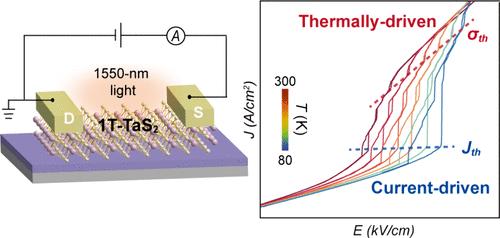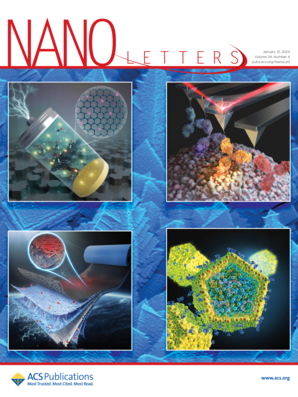Current-Driven to Thermally Driven Multistep Phase Transition of Charge Density Wave Order in 1T-TaS2
IF 9.1
1区 材料科学
Q1 CHEMISTRY, MULTIDISCIPLINARY
引用次数: 0
Abstract
Two-dimensional 1T-TaS2 is renowned for its exotic physical properties including superconductivity, Mott physics, flat-band electronics, and charge density wave (CDW) orders. In particular, the CDW phase transitions (PTs) in 1T-TaS2 attracted extensive research interest, showing prominent potential in electronic devices. However, mechanisms underlying electrically driven PTs remain elusive. Here, we systematically studied the evolution of multistep PTs during the I–V sweep in 1T-TaS2. Comprehensive investigations, covering variations in temperature, pulsed voltage duration, and light illumination, reveal that the underlying PT mechanism shifts from current-driven to thermally driven with increasing current. Initially, the current-driven PT step occurs at a constant current density, independent of the temperature. Subsequently, thermally driven PT steps manifest at a constant conductivity highly sensitive to the thermal effect. These transitions are strongly associated with the metastable CDW electronic structures and their response to carrier injection and thermal variations. Our findings reconcile long-standing debates regarding the electrically driven CDW PTs in 1T-TaS2.

电流驱动到热驱动的1T-TaS2中电荷密度波序的多步相变
二维1T-TaS2以其奇异的物理特性而闻名,包括超导性、莫特物理、平带电子学和电荷密度波(CDW)顺序。特别是1T-TaS2中的CDW相变(PTs)引起了广泛的研究兴趣,在电子器件中显示出突出的潜力。然而,电驱动PTs的机制仍然难以捉摸。在这里,我们系统地研究了1T-TaS2中I-V扫描期间多步PTs的演化。综合研究,包括温度、脉冲电压持续时间和光照的变化,揭示了潜在的PT机制随着电流的增加从电流驱动转变为热驱动。最初,电流驱动的PT步骤以恒定的电流密度发生,与温度无关。随后,热驱动PT台阶表现为恒定的电导率,对热效应高度敏感。这些转变与亚稳CDW电子结构及其对载流子注入和热变化的响应密切相关。我们的研究结果调和了长期以来关于1T-TaS2中电驱动CDW PTs的争论。
本文章由计算机程序翻译,如有差异,请以英文原文为准。
求助全文
约1分钟内获得全文
求助全文
来源期刊

Nano Letters
工程技术-材料科学:综合
CiteScore
16.80
自引率
2.80%
发文量
1182
审稿时长
1.4 months
期刊介绍:
Nano Letters serves as a dynamic platform for promptly disseminating original results in fundamental, applied, and emerging research across all facets of nanoscience and nanotechnology. A pivotal criterion for inclusion within Nano Letters is the convergence of at least two different areas or disciplines, ensuring a rich interdisciplinary scope. The journal is dedicated to fostering exploration in diverse areas, including:
- Experimental and theoretical findings on physical, chemical, and biological phenomena at the nanoscale
- Synthesis, characterization, and processing of organic, inorganic, polymer, and hybrid nanomaterials through physical, chemical, and biological methodologies
- Modeling and simulation of synthetic, assembly, and interaction processes
- Realization of integrated nanostructures and nano-engineered devices exhibiting advanced performance
- Applications of nanoscale materials in living and environmental systems
Nano Letters is committed to advancing and showcasing groundbreaking research that intersects various domains, fostering innovation and collaboration in the ever-evolving field of nanoscience and nanotechnology.
 求助内容:
求助内容: 应助结果提醒方式:
应助结果提醒方式:


